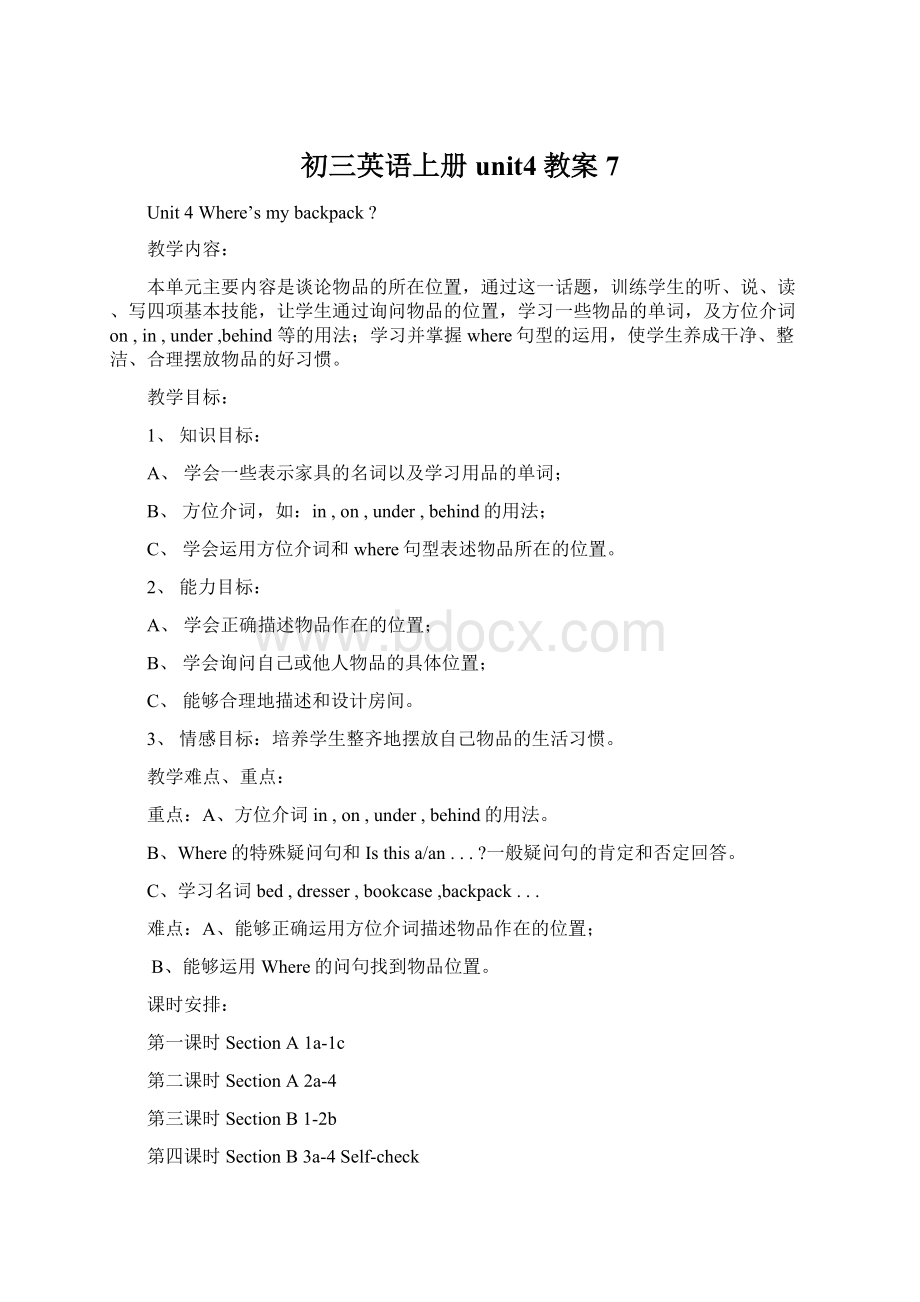初三英语上册unit4教案7.docx
《初三英语上册unit4教案7.docx》由会员分享,可在线阅读,更多相关《初三英语上册unit4教案7.docx(15页珍藏版)》请在冰豆网上搜索。

初三英语上册unit4教案7
Unit4Where’smybackpack?
教学内容:
本单元主要内容是谈论物品的所在位置,通过这一话题,训练学生的听、说、读、写四项基本技能,让学生通过询问物品的位置,学习一些物品的单词,及方位介词on,in,under,behind等的用法;学习并掌握where句型的运用,使学生养成干净、整洁、合理摆放物品的好习惯。
教学目标:
1、知识目标:
A、学会一些表示家具的名词以及学习用品的单词;
B、方位介词,如:
in,on,under,behind的用法;
C、学会运用方位介词和where句型表述物品所在的位置。
2、能力目标:
A、学会正确描述物品作在的位置;
B、学会询问自己或他人物品的具体位置;
C、能够合理地描述和设计房间。
3、情感目标:
培养学生整齐地摆放自己物品的生活习惯。
教学难点、重点:
重点:
A、方位介词in,on,under,behind的用法。
B、Where的特殊疑问句和Isthisa/an...?
一般疑问句的肯定和否定回答。
C、学习名词bed,dresser,bookcase,backpack...
难点:
A、能够正确运用方位介词描述物品作在的位置;
B、能够运用Where的问句找到物品位置。
课时安排:
第一课时SectionA1a-1c
第二课时SectionA2a-4
第三课时SectionB1-2b
第四课时SectionB3a-4Self-check
PeriodOne
教师:
准备一个带有家具的房间的多媒体课件或挂图,搜集图片、卡片、一些学习用品的实物,以及闹钟、光盘、数学书和其他日常用品。
学生:
彩笔
学生用品、大白纸、课本所涉及的单词的实物。
学步骤
StepOne:
PresenttheNewwords.
①Warmingup.
(Preparesomeschoolthingsforthestudentsaspresents.)
T:
What’sthis?
(Thereisapencilintheteacher’shand.)
S1:
Yesyouaright.Hereyouare.
(giveittothestudentasapresent.)
T:
Isthisaruler?
(holduparuler.)
S2:
Yesitis.
T:
Howtospellruler?
S2:
R-U-L-E-R,ruler.
T:
Good,hereyouare.
(Holdupapen,aneraser,anotebookandsoon.Askthequestionsinthesameway.Andgivethepresentstothestudents.)
T:
What’sthis?
S3:
It’sabackpack.
T:
Ihaveabackpackforyouasapresent,(Lookingforitinthedesk,underthechair...)butIcan’tfindit.Where’sit?
Doyouknow?
S3:
Idon’tknow.
S4:
Ithinkit’sinyourdesk..
T:
(Lookintothedesk.)No,itisn’t.Now,let’slookforthebackpacktogether,OK?
(Writedownthetitleontheblackboard.)
②LearntheNewwords.
T:
Lookatthebigpictureonthescreen.Thisisabigniceroom.Iwanttoownsucharoom.Becausethereissomenicefurnitureinit.Doyouknowthenamesofthefurniture?
(Showapictureofabedandadresser.)
T:
What’sthis?
It’sabed.“BED”.Readafterme.B-E-D,bed.
Ss:
B-E-D,bed.
T:
What’sthis?
It’sadresser.D-R-E-S-S-R,dresser.
Ss:
D-R-E-S-S-R,dresser.
(Teachtheotherwordsbookcase/sofa/chair/drawer/plant/...inthesameway.)
通过师生互动,激发学生思维,并用学过的句子导入新课。
利用多媒体课件创设情景,直观地呈现单词,使学生在语境中理解单词。
T:
Readthewordsaloud.
③Presentthewordsin,on,under,behindusingtheobjects.
T:
Whereismybook?
It’sonthedesk.(Putabookonthedesk.)
T:
Whereismybag?
(Putabagonthedeskandaskthisquestion.)
S1:
It’sonthedesk.
T:
Whereismybag?
(Toallthestudents)
Ss:
It’sonthedesk.
T:
Whereismypen?
It’sinthepencilcase.(Putapeninthepencilcaseandask.)
T:
Whereismyruler?
(Putarulerinthepencilcase,too.)
S1:
It’sinthepencilcase,too.
T:
Whereistheruler?
Ss:
It’sinthepencilcase.
(Thenlearntheothertwoprepositions“under”,“behind”inthesameway.)
④Presentthewords.
T:
Now,pleaselookatthescreen,whereistheballinPicture1?
S1:
Ithinkit’sinthebox.
T:
WhereistheballinPicture2?
S2:
It’sonthebox.
T:
WhereistheballinPicture3?
S3:
It’sbehindthebox.
T:
WhereistheballinPicture4?
S4:
It’sunderthebox.
T:
Therearesomepicturesonthescreen,pleasematchthesentencesandthepictures.
1:
Thecatisunderthechair.
2:
Thecatisonthebed.
3:
Thecatisbehindthedoor.
4:
Thecatisinthebox.
5:
Thecatisnexttotheplant.
通过实物所在的位置直观地呈现乏味介词。
利用多媒体课件创设语言情景,准确呈现物品之间的位置关系,让学生在真实的情景中理解和掌握方位介词。
让学生把句子和图画匹配起来,巩固方位介词的用法。
6:
Thecatisonthechair.
T:
Pleaseopenyourbooksanddo1aquicklyasyoucan.
(Afterdoing1a,checktheanswer.)
StepTwo:
drills.
①Practicethedrills.
T:
Thistime,usetheschoolthingsaroundyoutopracticetheconversation.
T:
Where’sthewatch?
(Holdupawatchinthehand.)
S1:
It’sinyourhand.
T:
Where’sthebag?
(Putabagonthechair.)
S2:
It’sonthechair.
(Askthestudentstopracticethedialoguelikethis.Thengetsomepairstoactitout.)
②Introducearoomandlistentothetape.
T:
ThisisTommy’sroom,buthecan’tfindhisbooks,hispencilcase,hisbaseball,hiscomputergameandhiskeys,pleasehelphimfindthethings.Listenandnumber[1-5]thethingsinthepicture.
(Playtherecordingandthenchecktheanswer.)
StepThree:
Playagame.
T:
Now,wewillplayagame,Ihaveanewruler,allthestudentscloseyoureyes,andIhideitinourclassroom.Pleaseguess,Whereisit?
Ifyouranswerisright,itisyours.PleaseasklikethisIsitonthedesk?
Isitonthefloor?
Areyouready?
S1:
Isitinthe...?
T:
No,itisn’t.
S2:
Isitunderthe…?
T:
No,itisn’t.
S3:
Isitbehindthe…?
T:
Yes,itis.Pleasefinditout.Hereyouare.(Givetherulertohim.)
(Askthreeorfourstudentstocometothefronttohidethreeorfournewschoolthings,otherslookforthem.)
T:
Whocancomeheretohidemynewpen?
Ss:
Ican.
(Afterplayingthegame,somestudentswhocanfindtheschoolthingswillhavethem.)
StepFour:
Task.
T:
Lookatthepictureonthescreen.ThisisMary’sroom.Ingroupsoffour,describewherethethingsareintheroom.(Prepare
让学生用身边的学习用品操练句型,达到熟练运用where提问。
用学过的一般疑问句以游戏的方式操练本节课所学内容以增强趣味性。
利用屏幕上所给图片,描述Mary房间物品的位置,强化句型。
Forfiveminutes.)
S1:
Isthebookonthedesk?
S2:
Yes,itis.Isthebackpackunderthechair?
S3:
No,itisn’t.It’s…Wherearethekeys?
S4:
Theyare…
Homework:
Makeaplay.
Thereisaman.Hisnameis“forgetful”.Healwaysforgetssomethings,andhealwaysasksWhereis/aremy…?
Pleasemakeashortplayandnextclasswewillactitout.
PeriodTwo
课前准备
教师:
准备表格、一些学习用品和多媒体教学课件。
学生:
表演短剧的道具、表格。
教学设计
StepOne:
Checkthehomework.(运用所学句型表演短剧。
)
(Thestudentspracticetheshortplay“forgetful”forthreeminutessothattheycanactitoutwell.)
T:
Whichgroupcanacttheplayout?
Ss:
Wecan.(Cometothefront.)
S1:
Mynameis“forgetful”,Iwanttowork,but,but…Wherearemy…?
S2:
(Cometohim)Aretheyonthe…?
S1:
No,itisn’t.
S3:
Aretheyinyour…?
S1:
Oh,yes,itis.ButwhereismyIDcard?
...
(Somegroupsactitout.)
StepTwo:
Reviewthewords.(利用多媒体教学课件复习学过的单词,为下面的听力训练做铺垫。
)
1.Askthestudentstospellthewordsinthepicturein2a.
T:
First,lookatthepicturesonthescreen.Whatarethese?
S1:
Theyarebooks.
T:
What’sthis?
S2:
It’sabaseball.
T:
What’sthis?
S3:
It’sacomputergame.
T:
Isthisabackpack?
S4:
Yes,itis.
T:
Canyouspellit?
S4:
Yes,B-A-C-K-P-A-C-K,backpack.
(Reviewtheotherwordsinthesameway.)
T:
Now,listentotherecordingandlookat2a.Numberthethingsfrom1-6.
T:
Checktheanswer.(Studentsgivetheanswer.)
T:
Now,listenagain.Let’sdo2b.FindoutWherearethethingsfrom2a?
Numberthethingsinthepictures[1-6].(通过听力训练检测学生对所学知识掌握的情况,培养学生听的能力。
)
(Playthetapeagainandchecktheanswer.)
T:
Whocananswer?
S1:
Thecomputergameisonthebackpack.
S2:
Thebooksare…
S3:
Thepencilcaseis…
S4:
Thebackpackis…
S5:
Thebaseballis…
S6:
Thekeysare…
StepThree:
Practicethedrills.(根据听力材料中的句型,利用图片再次进行巩固练习。
)
T:
Lookatthepicture.Isthebaseballonthechair?
Ss:
No,itisn’t.It’sunderthechair.
T:
Arethebooksunderthetable.
S:
No,theyaren’t.They’reonthechair.
…
(writethefoursentencesontheblackboard.Letthestudentsaskandanswerusingtheirownthigns.)
S1:
Isyourruleronyourpencilcase?
S2:
No,itisn’t.It’sinmy…
S3:
Areyourkeysinyourpocket?
S4:
No,theyaren’t.Theyareinmy…
(Letthemaskandanswerinpairsasmanyastheycantoimprovetheiroralability.)
StepFour:
Presentthegrammarandpractice.(利用实物呈现语法。
)
1.Grammarfocus.
(Theteachercollectssomeschoolthingsonherdesk,themhidesthemtoasksomequestions.)
T:
Whereisthebaseball?
(Putabaseballinthedesk)
S:
It’sin…
T:
Whereisthedictionary?
Ss:
It’son/under/behind…
T:
Where’rethebooks/yourkeys?
S:
They’reonthechair./inyourpocket…
(Thentheteacherwritesthesentencesontheblackboard.)
T:
Pleasepayattentiontothesentences.Weuse“It’s”totalkaboutsingleobjectsand“They’re”totalkabouttwoormoreobjects.
“Where’s,It’sandThey’re”arecontractions.
Makeasurvey.(运用调查表来巩固句型。
)
T:
Makeasurveyaboutyourclassmates’thingsusingWhereis/are…?
Andthenfillinthechart.
NameThings
Ruler
Pencilcase
Dictionary
Keys
Lucy
Tom
Tommy
Lily
2.Makeaconversation.(看图操练句型。
)
T:
Whocanputthesesentencesinordertomakeaconversationin3a.
S1:
Wecan.Where’sthebag?
S2:
Idon’tknow.Isitonthedresser?
S1:
No,itisn’t.
T:
Prepareanewdialogueforthreeminutesjustlikethis.Youcanuseyourownthings.
(Later,askmorepairstopracticetheirconversationsasquicklyastheycan.)
StepFive:
Practicethedrill“Whereis/are…?
”
(Makeaconversationwithastudent.)
T:
Lookatthepicturein3c.Wherearethebooks?
S1:
Idon’tknow.
T:
Wherearethekeys?
S2:
Theyareonthedresser.
T:
Workinpairs.Makeasimilarconversationlikethis.
S1:
Whereisthebaseball?
S2:
It’s…
S3:
Whereisthe…?
S4:
Idon’tknow.
S5:
Wherearethe…?
S6:
…
S7:
Whereisthepencilcase?
S8:
It’s…
(Letthestudentsaskandansweraccordingtothepicturein3corusingtheirownthings.)
StepSix:
Task.(设置任务,通过对比的方式让学生理解方位介词。
)
T:
StudentAlooksatPicture1(TextbookP21,4)studentBlooksatPicture2(TextbookP19,1a)Askandanswerinpairs.
Sample:
1.Sa:
Whereisthebackpack?
Isitunderthetable?
Sb:
No,itisn’t.It’sonthetable.
2.Sa:
Wherearethebooks?
Aretheyonthesofa?
Sb:
No,theyaren’t.Theyareonthebed.
…...
T:
Let’sfindoutthedifferencesbetweenthepictures.Whereisthebackpack?
Isitonthetable?
(LookatPicture1)
Ss:
No,itisn’t.It’sunderthetable.(LookatPicture2)
T:
Wherearethebooks?
Aretheybehindthesofa?
(Loo